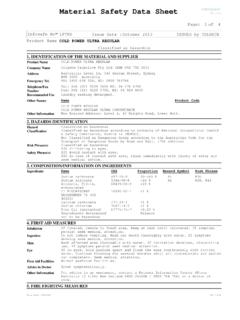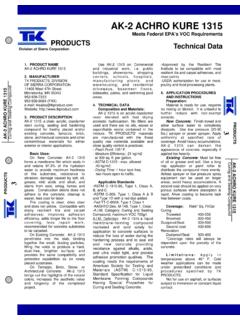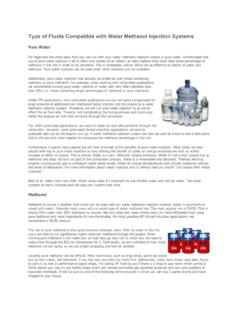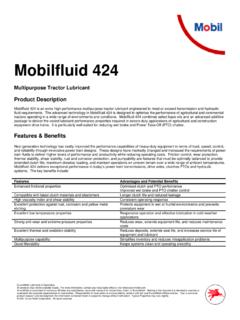Transcription of MATERIAL SAFETY DATA SHEET - Emerson
1 TQMTQMQ u a l i t y F i r s t T-36-05, SOCl2, general woIS, Rev J 1/7 Revised- May, 2015 msds No. - T-36-05 (Revision J) MATERIAL SAFETY DATA SHEET SECTION 1- CHEMICAL PRODUCT AND COMPANY IDENTIFICATION Manufacturer Name- Tadiran, US office address- 2001 Marcus Avenue, Suite 125E, Lake Success, NY 11040 US office address- 2001 Marcus Avenue, Suite 125E, Lake Success, NY 11040 Emergency Telephone No. CHEMTREC: 1-800-424-9300 Tel. for information: 1-516-621-4980 Tel. for information 972-8-944-4503 Products Name: Primary (non-rechargeable) Lithium metal Thionyl Chloride (Li/SOCl2) cells and batteries, Non-rechargeable.
2 Cells include the models of TL, TLH, and TLL, series. This msds covers the the above models: 2100, 2134, 2135, 2137, 2150, 2155, 2186, 2200, 2300, 2450, 4902, 4903, 4920, 4930, 4934, 4935, 4937, 4940, 4951, 4955, 4986, 5101, 5104, 5113, 5114, 5134, 5135, 5137, 5151, 5155, 5186, 5233, 5242, 5276, 5293, 5315, 5902, 5903, 5920, 5930, 5934, 5935, 5937, 5940, 5955, 5323, TL-7902, TL-7955, TL-7903, TL-7920, TL-7930, TL-7937, TL-8902, TL-8955, TL-8903, TL-8920, TL-8930, and TL-8937 with all their finishing versions and batteries assembled from them, denoted by / followed by letters or digits. SECTION 2- COMPOSITION, INFORMATION ON INGREDIENTS Ingredient Name CAS # % ACGIH (TLV) OHSA (PEL) CHIP Classification Lithium Metal (Li) 7439-93-2 <5% Not Established None F: R14/15 C: R34 R: 14/15, 34 S:(1/2), 8,43,45 Thionyl Chloride (SOCl2) 7719-09-7 <47% ppm 5 mg/m3 R: 14,20/22,29, 35.
3 S: (1/2),26,36/ 37/39, 45 Carbon (C) 1333-86-4 <6% mg/m3 mg/m3 None known Aluminum Chloride (AlCl3) 7446-70-0 <5% 2 mg/m3 (Al salt, soluble) R: 34 S: (1/2),7/8,28, 45 Lithium Chloride (LiCl) 7447-41-8 <2% Not Established Glass <1% Not Established PVC 9002-86-2 <1% Not Established PTFE 9002-84-0 <1% Not Established Steel, nickel, and inert components balance TLV- Threshold Limit Value is personal exposure limits determined by ACGIH (American Council of Governmental Industrial Hygienists). IMPORTANT NOTE: The above levels are not anticipated under normal use conditions. TQMTQMQ u a l i t y F i r s t T-36-05, SOCl2, general woIS, Rev J 2/7 Revised- May, 2015 SECTION 3 - HAZARD IDENTIFICATION The lithium Thionyl chloride batteries described in this msds are hermetically sealed units, which are not hazardous when used according to the recommendations of the manufacturer.
4 Under normal condition of use of the batteries, the electrode materials and the liquid electrolyte they contained are non-reactive provided the battery integrity is maintained. Risk of exposure exists only in case of mechanical, electrical or thermal abuse. Thus the batteries should not short circuit, recharge, puncture, incinerate, crush, immerse in water, force discharge, or expose to temperatures above the temperature range of the cell or battery. In these cases there is risk of fire or explosion SECTION 4- FIRST AID MEASURES In case of battery rupture, explosion, or major leakage, evacuate personnel from contaminated area and provide good ventilation to clear out corrosive fumes, gases or the pungent odor. Seek immediate medical attention. Eyes - First rinse with plenty of water for 15 minutes (remove contact lenses if easily possible), and then seek medical attention.
5 Skin - Remove contaminated clothes and rinse skin with plenty of water or shower for 15 min. Refer to medical attention. Inhalation - Remove to fresh air, rest, and half-upright position, use artificial respiration if needed, and refer to medical attention. Ingestion - rinse mouth, DO NOT induce vomiting, give plenty of water to drink, and refer to medical attention. SECTION 5- FIRE FIGHTING MEASURES FLASH POINT: NA LOWER (LEL): NA FLAMMABLE LIMIT IN AIR: NA UPPER (LEL): NA EXTINGUISHING MEDIA: 1. Lith- X (Class D extinguishing media) is the only effective on fires involving a few lithium batteries. If the cells are directly involved in a fire DO NOT USE: WATER, SAND, CO2, HALON, and DRY POWDER OR SODA ASH EXTINGUISHERS. 2. If the fire is in adjacent area and the cells that are either packed in their original containers or unpacked, the fire can be fought based on fueling MATERIAL , , paper and plastic products.
6 In these cases the use of copious amounts of cold water is effective extinguishing media. Storage area may also employ sprinkler system with cold water. AUTO-IGNITION: NA TQMTQMQ u a l i t y F i r s t T-36-05, SOCl2, general woIS, Rev J 3/7 Revised- May, 2015 SPECIAL FIRE FIGHTING PROCEDURES: Wear self-contained breathing apparatus to avoid breathing of irritant fumes (NIOSH approved SCBA & full protective equipment). Wear protective clothing and equipment to prevent body contact with electrolyte solution. Fire may be fought, but only from safe fire-fighting distance. Evacuate all persons from immediate area of fire. UNUSUAL EXPLOSION AND FIRE EXPLOSION: Battery may explode when subject to: excessive heat (above 150 C), recharged, over-discharged (discharge below 0V), punctured and crushed.
7 During thermal decomposition generation of chlorine (Cl2), hydrogen chloride (HCl), and sulfur dioxide (SO2) can be formed. SECTION 6- SPILL OR LEAKAGE PROCEDURES PROCEDURES TO CONTAIN AND CLEAN UP LEAKS OR SPILLS: The MATERIAL contained within the battery would only be released under abusive conditions. In the event of battery rapture and leakage: contain the spill while wearing proper protective clothing and ventilate the area. Then, cover with sodium carbonate (Na2CO3) or 1:1 mixture of soda ash and slaked lime. Keep away from water, rain, and snow. Placed in approved container (after cooling if necessary) and disposed according to the local regulations. NEUTRALIZING AGENTS: Sodium carbonate (Na2CO3) or 1:1 mixture of soda ash and slaked lime. WASTE DISPOSAL METHOD: Product decomposed by water must be neutralized.
8 If sufficiently diluted, it may be added to waste water if it is sufficiently diluted. PRECAUTIONS IN HANDLING AND STORAGE: avoid short-circuiting, over-charging and heating to high temperatures. Store the batteries in dry and cool area and keep container dry and tightly closed in well-ventilated area. Store cells away from food and drink. OTHER PRECAUTIONS; Never attempt to disassemble, machine, or otherwise modify batteries or injury may result. SECTION 7- HANDLING AND STORAGE The batteries should not be opened, destroyed or incinerate, since they may leak or rupture and release to the environment the ingredients that they normally contained in the hermetically sealed container. HANDLING- Do not short circuit terminals, or expose to temperatures above the temperature rating of the battery, over charge the battery, forced over-discharge (voltage below ), throw to fire.
9 Do not crush or puncture the battery, or immerse in liquids. STORAGE- is preferably done in cool (below 30 C), dry and ventilated area, which is subject to little temperature change. Do not place the battery near heating equipment, nor expose to direct sunlight for long periods. Elevated temperatures can result in shortened battery life and degrade performance. Keep batteries in original packaging until use and do not jumble them. Do not store batteries in high humidity environment for long periods. TQMTQMQ u a l i t y F i r s t T-36-05, SOCl2, general woIS, Rev J 4/7 Revised- May, 2015 OTHER- cells and batteries are not rechargeable batteries and should not be charged. Applying pressure and deforming the battery may lead to disassembly followed by eye skin and throat irritation.
10 Follow manufacturer recommendations regarding maximum recommended current and operating temperature range. SECTION 8 - EXPOSURE CONTROLS & PERSONAL PROTECTION GENERAL- The following SAFETY measures are not necessary in normal use. They need only be applied if there is a risk that, in use or handling, the recommendations, as outlined in Section 3, have not been followed. RESPIRATORY PROTECTION: In case of abuse or leak of liquid or fumes, use NIOSH approved Acid Gas Filter Mask or Self-Contained Breathing Apparatus. VENTILATION: In case of abuse, use adequate mechanical ventilation (local exhaust) for battery that vents gas or fumes. PROTECTIVE GLOVES: In case of spill use PVC or Nitrile gloves of 15 mils ( inch) or thicker. EYE PROTECTION: Use ANSI approved chemical worker SAFETY goggles or face shield.
















